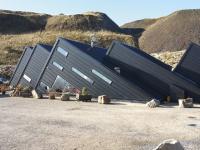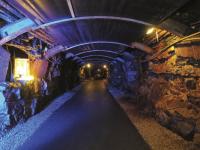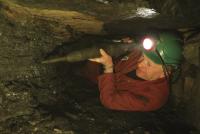Museum eye : Arigna Mining Experience Arigna, Co. Roscommon
Published in 20th-century / Contemporary History, Issue 1(Jan/Feb 2012), Reviews, Volume 20
The centre is a striking modern building, which is divided into a museum, a café and a gift shop.
Coal has been mined in Ireland for centuries and was extracted from the Arigna mountain from the seventeenth century until recently. This could have been a lost heritage had it not been decided to turn the last remaining mine into a tourist attraction. En route to the Mining Experience you pass a coal plant in Arigna village that produces smokeless fuel from imported coal but is a reminder that this was once a bustling industrial region. The centre is a striking modern building, which is divided into a museum, a café and a gift shop.The museum displays mining equipment such as picks, shovels, helmets, lamps and so on. The information panels tell the story of Irish geology, the mine and the local community. Coal was originally extracted to help in the processing of iron ore. This can still be found in nearby Sliabh an Iarainn (‘iron mountain’) and in the Arigna River, in deposits ranging in size from a pebble to a rugby ball. Dublin’s famous Ha’penny Bridge was made of Arigna iron.The mine was opened by Charles Coote in the 1600s and passed through a number of hands over the centuries, including those of the O’Reilly brothers, who were United Irishmen, and latterly was owned by local families. It used to supply a purpose-built ESB station, but when that closed down the mine was no longer viable. In 1992 the last of the coal stocks ran out and the power station was decommissioned.Shortly before it closed down for good, someone took a camera and filmed a day in the mine. It shows blasting, machines cutting though rock to access the seams, and the work done by the miners. Access to the mine itself is via a guided tour, and the video does not prepare you for the reality of going underground. The guides, like Michael who took us down, are all former miners, so they know what they are talking about. The original ‘straight road’, or main tunnel, was only 4ft high and just wide enough to take two hutches (trolleys), so the miners had to stoop or crawl the mile or two to the coalface at the start of the working day and back again at the end.

The ‘straight road’, or main tunnel, has been widened and heightened for tours but is still a forbidding place. The original was only 4ft high and just wide enough to take two hutches (trolleys), so the miners had to stoop or crawl the mile or two to the coalface at the start of the working day and back again at the end.
After we had donned our safety helmets, Michael took us into the mine. The straight road has been widened and heightened for tours but is still a forbidding place. Water drips down continually, and although a steel canopy has been installed to protect visitors you can still get dripped on if not careful. Over the entrance is a statue of the Virgin Mary and inside is one of the Sacred Heart. Every miner would say a prayer for protection before going into the mine. As Michael explained, with no real health or safety regulations this was their only insurance against mishap or disaster.As he led us through the complex of tunnels, Michael explained how the coal was extracted and regaled us with stories of his own time there, of the different characters and incidents. Everyone was found a job in the mine. Those not inclined or able to work at the coalface helped to carry the coal to the surface. Old miners were employed as handymen, repairing pit props, maintaining the hutches and so on. They also acted as de facto health and safety officers, giving advice to the younger men and warning them of the pitfalls they might encounter.At the end of the tunnel are the remains of an explosion—boulders and smaller rocks waiting to be carried away to expose the coal seam. Michael explained how the other tunnels, known as slopes, branched off at angles from the straight road. These cut through the coal seams, which were then tunnelled into via branches. As the seams were usually between 16in. and 20in. thick, this was the size of the tunnel that the miner had to work in, lying on his side and hacking away with a pick. The coal was then shovelled out of the branch and loaded onto a hutch. Even then the physical work was not over, as the hutch had to be manhandled back to the straight road to be put on the rails so that it could be pulled to the surface.

As the seams were usually between 16in. and 20in. thick, this was the size of the tunnel that the miner had to work in, lying on his side and hacking away with a pick.
(All images: Arigna Mining Experience)
As we moved on through the tunnels, Michael explained how the introduction of machines made it easier to get at the coal but still left a lot to be done by hand. He gave us details of the working conditions, what the ‘goose’ was used for and how rats could save a miner’s life. Despite the working conditions and the casual attitude to the use of explosives, there were very few accidents or fatalities in the mine’s history. Nevertheless, as the men worked in cold, damp air that was always thick with coal dust, untold damage was done to their health.The tour lasts about 45 minutes, which just fly past. At the same time, I was never so glad to see daylight as when we began to climb back up and I caught my first glimpse of the exit. Ireland’s industrial heritage is beginning to emerge from the shadow of the dominant view that we were a rural nation. The Arigna mine was a crucial part of that heritage and I would recommend a visit to everyone. HI
















